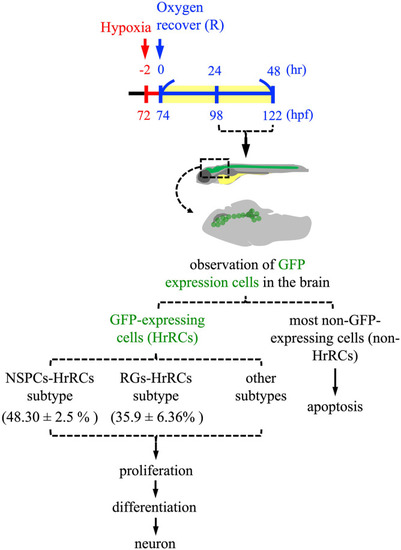Fig. 7
- ID
- ZDB-FIG-230312-45
- Publication
- Zeng et al., 2022 - Hypoxia-Responsive Subtype Cells Differentiate Into Neurons in the Brain of Zebrafish Embryos Exposed to Hypoxic Stress
- Other Figures
- All Figure Page
- Back to All Figure Page
|
Cell fate of NSPC subtype cells which are highly sensitive to hypoxia stress in the brain of hypoxia-exposed zebrafish embryos during oxygen recovery. The embryos developed at 72 hpf from zebrafish transgenic line huORFZ were exposure to hypoxia for 2 h, followed by recovery with oxygen for 9 h (R9) to R48. During oxygen recovery within 48 h, the GFP-expressing cells [GFP(+)], which are cells highly sensitive to hypoxia, termed as HrRCs, are found in the brain at R9. Brain HrRCs are mostly composed of NSPCs and RGs. While most negative GFP-expressing cells [GFP(−)] are apoptotic during recovery from stress, GFP-expressing HrRCs are not. Instead, some HrRCs, such as a group of NSPC subtype cells (NSPCs-HrRCs subtype) and RG subtype cells (RGs-HrRCs subtype), could undergo proliferation and differentiation into neurons during regeneration. NSPCs: neural stem/progenitor cells; hpf: hours postfertilization; HrRCs: hypoxia-responsive recovering cells; RGs: radial glia cells. |

